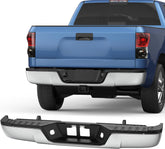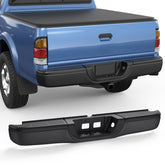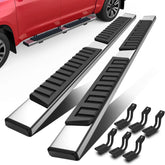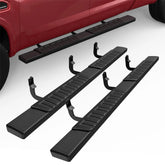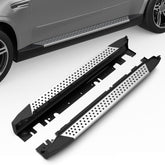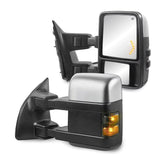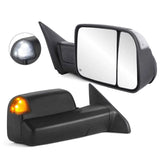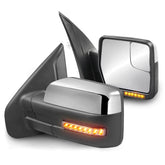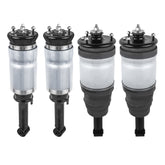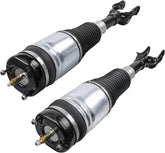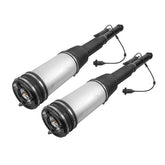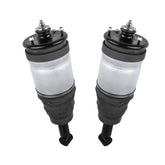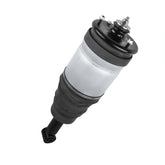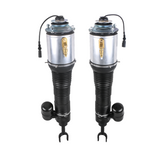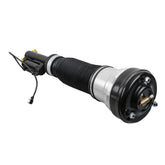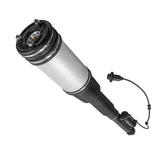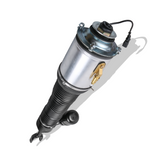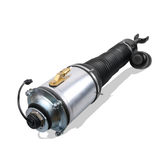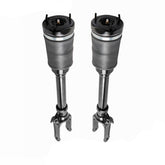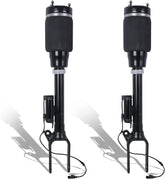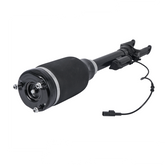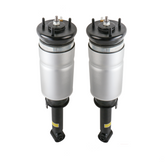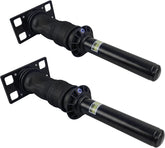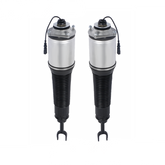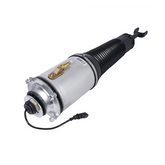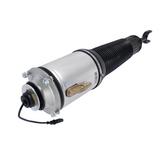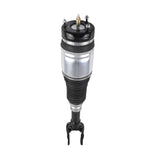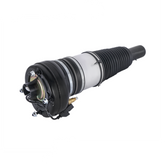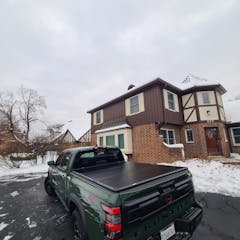Filter
49 results
20
- 10
- 15
- 20
- 25
- 30
- 50
Featured
- Featured
- Best selling
- Alphabetically, A-Z
- Alphabetically, Z-A
- Price, low to high
- Price, high to low
- Date, old to new
- Date, new to old
Sort
Sort by:
- Featured
- Best selling
- Alphabetically, A-Z
- Alphabetically, Z-A
- Price, low to high
- Price, high to low
- Date, old to new
- Date, new to old
-
Front & Rear Air Suspension Struts For Land Rover LR3 LR4 Range Rover Sport (Set of 4)Vendor: MOSTPLUSDetails: Brand: MOSTPLUS Warranty: 1 Year Fitment Type: Direct Replacement Placement on Vehicle: Left, Right, Front, Rear Other Part Number: RNB501250, RNB501480, RPD000308, RPD000309 Specification: Type: Air Suspension Strut OE Spec or Performance/Custom: OE Spec Interchange Part Number: Front Side (2pcs): RNB501180, RNB501220, RNB501250,...
- $668.69
- $668.69
- Unit price
- / per
-
Front Air Suspension Spring & Shock For 2011-2016 Jeep Grand Cherokee 68029903AE (Set of 2)Vendor: MOSTPLUSDetails: Brand: MOSTPLUS Warranty: 1 Year Fitment Type: Direct Replacement Placement on Vehicle: Front Specification: Type: Air Suspension Strut Exterior Finish: Black Material: Aluminum Shell + Plastic + Iron OEM Part Number: 68029903AE, 68029903AC, 68029903AD, 68080195AB, 68080195AA, 68059905AD, 68059905AB, 68059905AC, 68059904AD, 68059904AB, 68059904AC, 68029902AE,...
- $459.99
- $459.99
- Unit price
- / per
-
Rear Air Suspension Strut Shocks For 2000-2006 Mercedes-Benz S-Class W220 S430 S500 (Set of 2)Vendor: MOSTPLUSDetails: Brand: MOSTPLUS Warranty: 1 Year Placement on Vehicle: Left, Right, Rear Fitment Type: Direct Replacement Reference OE/OEM Number: 2203205013, 2203205013, 220320501360, 220320501380, 220320501388, A2203205013, A220320501360, A220320501380, A220320501388, 2203202338, 2203202338, A2203202338, A2203202338 Specification: Shock Absorber Type: Gas Shock Absorber System: Double Pipe Internal Design:...
- $349.99
- $349.99
- Unit price
- / per
-
Rear Air Shock Suspension For 2006-2014 Range Rover Sport Land Rover Discovery (Set of 2)Vendor: MOSTPLUSDetails: Brand: MOSTPLUS Warranty: 1 Year Placement on Vehicle: Left, Right, Rear Other Part Number: RPD501030, RPD501110, LR016419 Specification: Type: Air Suspension Strut Interchange Part Number: Land Rover RPD000305 Land Rover RPD000306 Land Rover RPD000308 Land Rover RPD000309 Land Rover RPD500830 Land Rover RPD500880...
- $356.99
- $356.99
- Unit price
- / per
-
Rear Air Suspension Strut For 2005-2014 Land Rover Discovery 2006-2014 Range Rover Sport Left/ RightVendor: MOSTPLUSDetails: Brand: MOSTPLUS Warranty: 1 Year Surface Finish: Remanufactured OE/OEM Part Number: LR016402, LR016404, LR016411, LR016418, LR038096 Interchange Part Number: LR016402, LR016404, LR016411, LR016418, LR032650, LR038096, LR041110, RPD000305, RPD000306, RPD000308, RPD000309, RPD500880, RPD501090, RPD501020, RPD501030, RPD501100, RPD501110, RKB500250,RPM500010 RPM500210,RPD500790, RPD500910,RPD500010 RPD501020,RPD501100, RPD501030,RPD 501030 RPD501110,RPD...
- $179.72
- $179.72
- Unit price
- / per
-
Front Air Suspension Struts For 2003-2012 Bentley Continental GT 2006-2012 Flying Spur (Set of 2)Vendor: MOSTPLUSDetails: Brand: MOSTPLUS Warranty: 1 Year Goods Condition: Remanufactured Placement on Vehicle: Front, Left, Right Quantity Sold: 2 Pieces OE/OEM Part Number: Front Left: 3W8616039, 3W8616039E, 3W8616039F, 3W8616039G, 3W8616039C, 3W8616039H, 3W5616039, 3W5616039M, 3W5616039L, 3W0616039, 3W0616039K, 3W0616039C, 4W0616039, 4W0616039B, 4W0616039C Front Right: 3W8616040, 3W8616040E, 3W8616040F,...
- $669.99
- $669.99
- Unit price
- / per
-
Front Air Suspension Strut For 2000-2006 Mercedes Benz S-Class S430 S500 S600 Left/ RightVendor: MOSTPLUSIntroductions: Our Front Left / Right Air Suspension Air Shock is brand new & high quality aftermarket product. Manufactured from top quality components, it is a great value replacement for your old factory air suspension. It is durably built and precisely engineered for improved...
- $178.25
- $178.25
- Unit price
- / per
-
Rear Air Suspension Strut For Mercedes-Benz W220 S430 S500 S55 AMG Right / LeftVendor: MOSTPLUSDetails: Brand: MOSTPLUS Warranty: 1 Year OE/OEM Part Number: 2203205013, 2203202338, 2203207813, 2203207913 Interchange Part Number: 949861, 4J2001S, SKAS022, AS7334, 2203205013, 2203202338, 2203207813, 2203207913 Engine: V8 4.3L, V8 5.0L, V8 5.5L Placement on Vehicle: Left, Rear, Right, Rear Driver or Passenger Side Fitment Type:...
- $179.12
- $179.12
- Unit price
- / per
-
Front Driver Side Air Strut For 2003-2018 Bentley Continental 2004-2006 VW PhaetonVendor: MOSTPLUSDetails: Brand: MOSTPLUS Warranty: 1 Year OE/OEM Part Number: 3D0616039N,3D0616039AA Interchange Part Number: AS3128, 45260445, 3W0616039M, 3W8616039K, 3D0616039L, 3D0616039N, 3D0616039AA Engine: V8 4.0L, W12 6.0L, V8 4.2L Placement on Vehicle: Front, Left, (Front Driver Side) Fitment Type: Direct Replacement Quantity Sold: One Piece Includes...
- $319.95
- $319.95
- Unit price
- / per
-
Front Passenger Side Air Suspension Struts For 2003-2018 Bentley Continental 2004-2006 VW PhaetonVendor: MOSTPLUSDetails: Brand: MOSTPLUS Warranty: 1 Year OE/OEM Part Number: 3D0616040N,3D0616040AA Interchange Part Number: AS3127, 45260452, 3W0616040M, 3W8616040K, 3D0616040L, 3D0616040N, 3D0616040AA Engine: V8 4.0L, W12 6.0L, V8 4.2L Placement on Vehicle: Front, Right, (Front Passenger Side) Fitment Type: Direct Replacement Quantity Sold: One Piece Includes...
- $319.95
- $319.95
- Unit price
- / per
-
2x Front Air Suspension Spring Struts For Mercedes-Benz GL320 GL450 ML350 ML500Vendor: MOSTPLUSONE YEAR WARRANTY Specification Brand New OEM NO.: A1643204513, A1643206113,1643204513, 1643206113 Package Includes:2x Air Suspension Struts (Front Left & Right) Fitment Mercedes-Benz GL-Class GL320 Bluetec 4Matic Sport Utility 4-Door 3.0L 2009 GL320 CDI Sport Utility 4-Door 3.0L 2007-2008 GL350 Bluetec 4Matic Sport Utility 4-Door...
- $330.99
$370.99- $330.99
- Unit price
- / per
-
Front Air Suspension Struts w/ ADS For 2005-2011 Mercedes-Benz GL-Class X164 | ML-Class W164 GL350 450 550 ML450 (Set of 2)Vendor: MOSTPLUSDetails: Brand: MOSTPLUS Warranty: 1 Year Material: Iron & Rubber & Plastic Shock Absorber System: Double Pipe Gas Charged Shock: Yes Shock Absorber Type: Gas OE Part Number: 1643206013; 1643205813; 1643200130; 1643200131; 1643204313; 1643204613 Fitment Type: Direct Replacement Placement on Vehicle: Front, Left, Right...
- $408.94
- $408.94
- Unit price
- / per
-
Front Air Suspension Strut w/ ADS For 2005-2011 Mercedes-Benz ML-Class 2007-2012 GL-Class Left or RightVendor: MOSTPLUSDetails: Brand: MOSTPLUS Warranty: 1 Year Material: Iron & Rubber & Plastic Surface Finish: Yes OE Part Number: 1643206013; 1643205813; 1643200130; 1643200131; 1643204313; 1643204613 Placement on Vehicle: Front, Left, Right Interchange Part Number:1643206013, 164 320 60 13, A1643206013, A 164 320 60 131643204613, 164...
- $219.47
- $219.47
- Unit price
- / per
-
Front Air Suspension Struts For Land Rover Range Rover Sport LR3 LR4 (Set of 2)Vendor: MOSTPLUSDetails: Brand: MOSTPLUS Warranty: 1 Year OEM Part Number: RNB501580, RNB000855, RNB000856, RNB000857, RNB000858, RNB501180, RNB501250, LR013930 LR014194 LR018398 LR032646 Fitment Type: Direct Replacement Placement on Vehicle: Front, Left, Right Feature: PREMIUM MATERIAL: The absorber shocks are made of premium metal, aluminum alloy, and...
- $339.97
- $339.97
- Unit price
- / per
-
Rear Side Cab Shock Absorber Air Spring Strut For 2008-2017 International Harvester ProStar 3595977C95 3595977C96 (Set of 2)Vendor: MOSTPLUSDetails: Brand: MOSTPLUS Warranty: 1 Year Adjustable: Yes Included Hardware: None Fitment Type: Direct Replacement Placement on Vehicle: Left, Rear, Right Specification: Color: Black Material: Iron Single Dimension(CM): 65.00 (length) * 22.00 (width) * 13.00 (height) Single Weight (KG): 5.900 Upper Mount Type: Stud...
- $169.93
- $169.93
- Unit price
- / per
-
Front Air Suspension Struts For 2002-2010 Audi A8 D3 Quattro S8 Base Sedan 4-Door 2pcsVendor: MOSTPLUSDetails: Brand: MOSTPLUS Warranty: 1 Year Fitment Type: Direct Replacement Placement on Vehicle: Left, Right, Front Specification: Material: Iron, Aluminium Alloy, Rubber Single Dimension(CM): 84.00 (Length) * 21.00 (Width) * 21.00 (Height) Minimum Operating Pressure (psi): 90 Maximum Operating Pressure (psi): 160 Interchange Part...
- $579.88
- $579.88
- Unit price
- / per
-
Front Left Air Suspension Strut For 2002-2010 Audi A8 Quattro D3 4WD 4.2LVendor: MOSTPLUSDetails: Brand: MOSTPLUS Warranty: 1 Year Fitment Type: Direct Replacement Placement on Vehicle: Left, Front Specification: Material: Iron, Aluminium Alloy, Rubber Single Dimension (CM): 84.00 (Length) * 21.00 (Width) * 21.00 (Height) Minimum Operating Pressure (psi): 90 Maximum Operating Pressure (psi): 160 Adjustable: Yes...
- $299.97
- $299.97
- Unit price
- / per
-
Front Right Air Suspension Strut For 2002-2010 Audi A8 Quattro D3 4WD 4.2LVendor: MOSTPLUSDetails: Brand: MOSTPLUS Warranty: 1 Year Fitment Type: Direct Replacement Placement on Vehicle: Right, Front Specification: Material: Iron, Aluminium Alloy, Rubber Maximum Operating Pressure (psi): 160 Minimum Operating Pressure (psi): 90 Adjustable: Yes Upper Mount Type: Stud Lower Mount Type: U-Bracket Platform: D3 (4E)...
- $299.97
- $299.97
- Unit price
- / per
-
Front Left Side Air Suspension Shock For 2011-2014 Jeep Grand Cherokee 68029903ACVendor: MOSTPLUSDetails: Brand: MOSTPLUS Warranty: 1 Year Feature: Sealed Fitment Type: Direct Replacement Placement on Vehicle: Front, Left Feature: Excellent Shock Absorption: The air shock absorber reduces the frequency of vibration. No squeaking noise, long durability. It can keep your vehicle's tires in contact with...
- $239.99
- $239.99
- Unit price
- / per
-
Front Air Suspension Strut For 2010-2018 Audi A6 S6 A7 A8 S8 Quattro 4H0616040PVendor: MOSTPLUSDetails: Brand: MOSTPLUS Warranty: 1 Year Fitment Type: Direct Replacement Placement on Vehicle: Front, Left, Right Specification: Shock Absorber Type: Gas Shock Absorber System: Double Pipe OEM Part Number: 4H0616039T, 4H0616039AR, 4H0616039AP, 4H0616039AQ, 4H0616039AF, 4H0616039AK Feature: High Quality: Made of high-quality material rubber, with...
- $279.93
- $279.93
- Unit price
- / per
